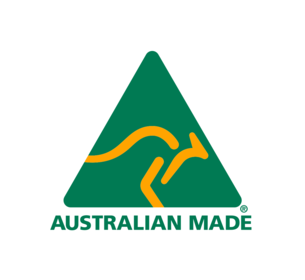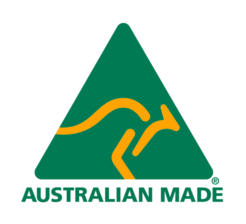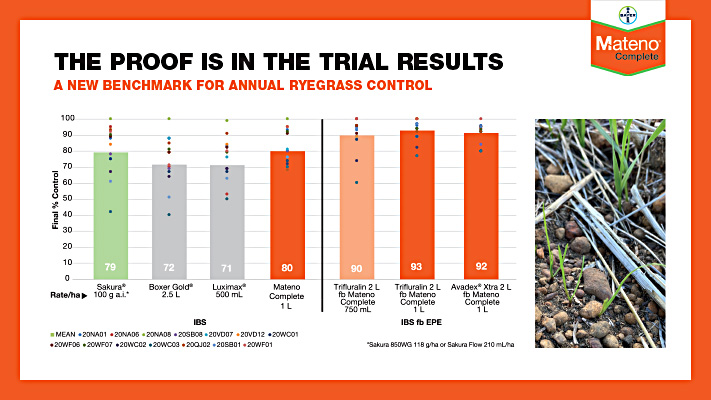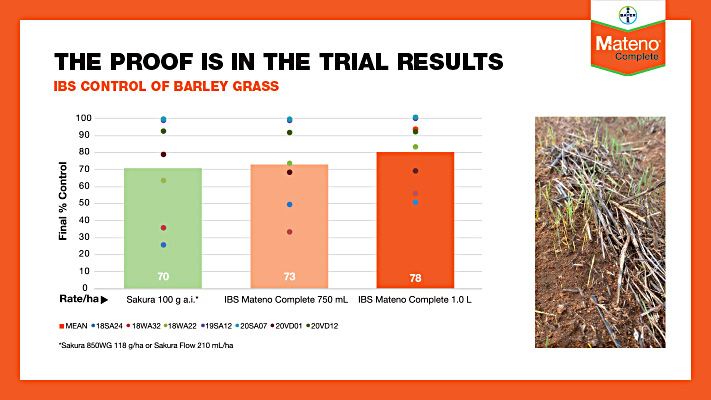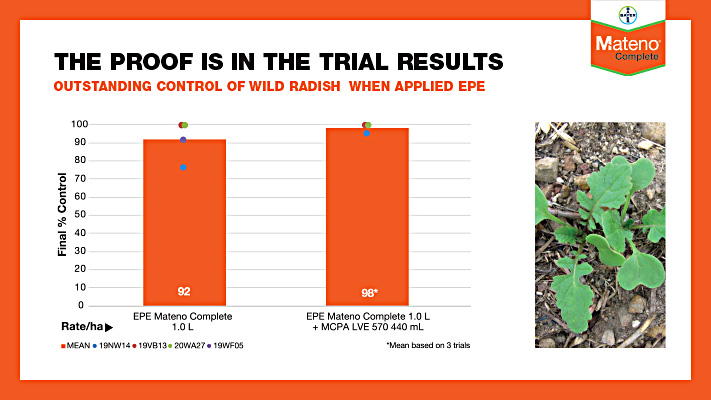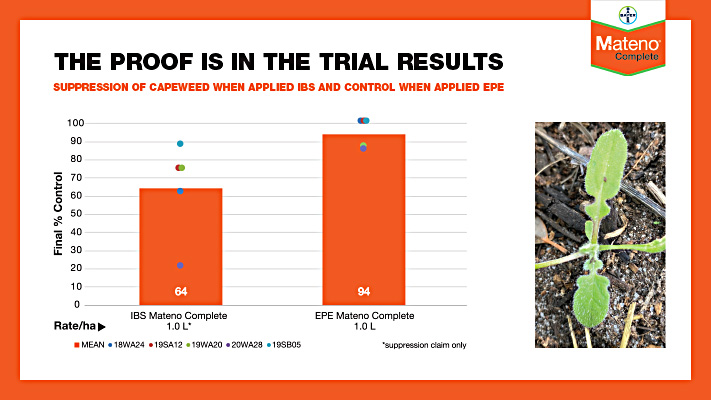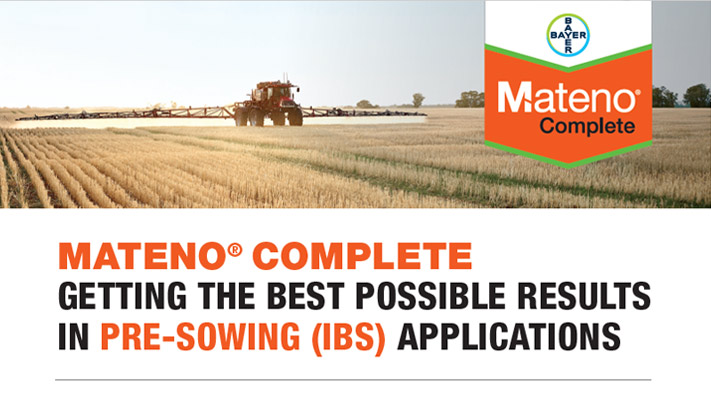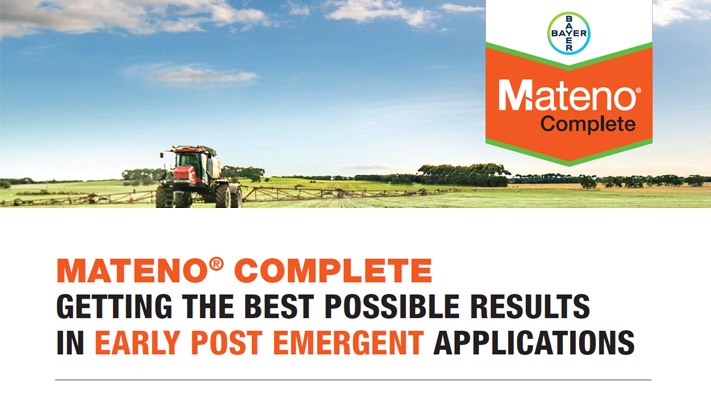| Why has Bayer developed Mateno Complete? |
Bayer has developed Mateno Complete Herbicide to provide a new tool to deliver class leading levels of residual grass weed control and broad-spectrum broadleaf weed control. Mateno Complete has the flexibility to be used IBS (incorporated by sowing) or EPE (Early post emergent) in wheat and barley and the ability to be used with knife point press wheel or disc seeding systems (wheat only). |
| What are the active ingredients in Mateno Complete? |
Mateno Complete contains three active ingredients; aclonifen, pyroxasulfone and diflufenican. Aclonifen is a new active ingredient in the Australian market.
|
| Which Herbicide Mode of Action (MOA) Groups do the active ingredients in Mateno Complete belong to? |
The active ingredients in Mateno Complete are from three different Herbicide MOA groups; aclonifen (Group 32), pyroxasulfone (Group 15, formerly Group K), and diflufenican (Group 12, formerly Group F). |
| What mode of action does aclonifen have? |
Aclonifen has been classified as an SPS inhibitor. Currently it is the only active ingredient globally that is classified as a Group 32 herbicide.
|
| What does aclonifen bring to Mateno Complete? |
Aclonifen is a herbicide that has activity on both grass weeds and broadleaf weeds and works best when in combination with other herbicides due to its synergistic properties.
|
| What does herbicide synergy mean? |
Herbicide synergy is the outcome of an interaction between two or more active ingredients that results in a combined level of performance which is greater than the expected outcome from the combination of the (known) performance of the individual active ingredients.
|
You’ve called aclonifen a synergist? What does that mean for Mateno Complete?
|
Synergy is complex and often involves two or more modes of action. Globally aclonifen has been recognized as a synergist in combination with certain other herbicides. Aclonifen has patented synergy in combination with pyroxasulfone and diflufenican, the three active ingredients that make up Mateno Complete. This means that when formulated together in Mateno Complete, these three active ingredients deliver a combined performance far higher than would be expected from the known performance of the individual active ingredients.
|
| Is Mateno Complete available to purchase? |
Registration for Mateno Complete is now approved. Product is now being produced and despatched. Contact your Bayer agent to order or for more details.
|
In what pack sizes is Mateno Complete available?
|
Mateno Complete is available in both 10 L and 100 L packs.
|
In which crops can I use Mateno Complete?
|
Mateno Complete is registered for use in both wheat and barley.
|
Can I use Mateno Complete at different application timings?
|
Mateno Complete can be used at either the IBS (Incorporated By Sowing) timing or the EPE (Early Post Emergence) timing in wheat or barley.
|
| At what crop stage do I apply Mateno Complete when I use it EPE (Early Post Emergence) in wheat? |
Mateno Complete is active on weeds via both root and shoot uptake with the best results delivered when weeds are small (up to 2, 3 or 4 leaf, depending on the weed species) and good coverage of the weeds and soil is possible (to control current and future weed germinations). Mateno Complete can be applied in wheat from the 1 true leaf stage (Z11) in wheat or from the 3 leaf stage (Z13) in barley. The latest possible timing that Mateno Complete can be used is at crop growth stage Z23.
|
| What are the application rates for Mateno Complete? |
Mateno Complete has a flexible rate range of 750 mL/ha to 1 L/ha when used in wheat at either IBS or EPE application timing. . Under scenarios of high weed pressure, the higher rate should always be used in wheat with consideration of a suitable a tank mixture partner when using the 750 mL/ha rate. When used in barley at the IBS or EPE timing, the application rate is 750 mL/ha. |
Which weeds does Mateno Complete target?
|
Mateno Complete targets a broad spectrum of hard-to-control grass and broadleaf weeds. Grass weed targets include annual ryegrass, barley grass, toad rush (a sedge), silver grass, annual phalaris, great brome and wild oats. Broadleaf weed targets include wild radish, capeweed, Indian hedge mustard, stonecrop, denseflower fumitory, deadnettle, volunteer canola, lesser loosestrife, wireweed, mouse-ear chickweed, doublegee/spiny emex and prickly lettuce.
|
Can I use Mateno Complete at the EPE timing following Sakura applied IBS?
|
No. Mateno Complete should not be used in conjunction with or following the use of Sakura® herbicide, due to herbicide rotation guidelines, as well as potential crop safety, residue and recropping interval impacts.
|
Is Mateno Complete compatible with other post-emergent products?
|
Bayer has conducted a comprehensive range of compatibility trials with common pre-emergent and post-emergent herbicides, fungicides and insecticides. For more detail refer to the Product Label or Mixing Guide available on the Mateno Complete webpage. The use of higher water rates (≥80 L/ha) can aid compatibility. The use of coarse inline filters (i.e. 50 mesh) can improve performance in sprayers. |
| Can I mix Mateno Complete with other crop protection products for use EPE in barley? |
It is not recommended to mix Mateno Complete with other crop protection products when used EPE in barley. Consult Bayer Crop Science for further information. |
Can I use Mateno Complete IBS with a disc seeding system?
|
Mateno Complete has a good fit for use in disc-seeding systems in wheat. Trials have shown comparable safety to existing pre-emergence herbicides currently registered or recommended for use with disc seeding systems in wheat. The product label outlines important guidelines for maximizing crop safety in disc-seeding scenarios. Mateno Complete should not be used in combination with a disc seeding system in barley. |
Are there rotational crop restrictions with Mateno Complete?
|
Plant back restrictions are largely dictated by the pyroxasulfone component of the co-formulation, please see the label for full details. |
Are all intended registrations on the current Mateno Complete label?
|
A number of label extensions are planned for Mateno Complete, so the current label does not contain all the intended registrations. We will also continue to evaluate the effectiveness of Mateno Complete on additional target weeds and use patterns for further label expansion.
|




